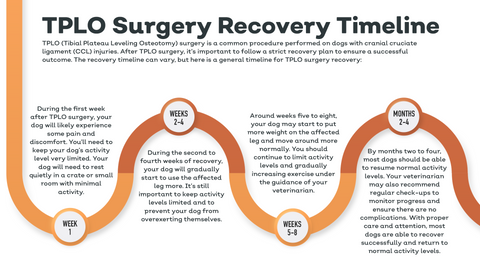TPLO (Tibial Plateau Leveling Osteotomy) surgery is a common procedure performed on dogs with cranial cruciate ligament (CCL) injuries. The surgery involves cutting and repositioning the tibial plateau, a part of the dog's knee joint, to stabilize the joint and prevent further damage to the ligament.
After TPLO surgery, it's important to follow a strict recovery plan to ensure a successful outcome. The recovery timeline can vary depending on the dog's age, size, and overall health, as well as the extent of the surgery and the surgeon's instructions. However, here is a general timeline for TPLO surgery recovery:
Week 1
During the first week after TPLO surgery, your dog will likely experience some pain and discomfort. Your veterinarian will likely prescribe pain medications to help manage this. You'll also need to keep your dog's activity level very limited. This means no running, jumping, or playing. Instead, your dog will need to rest quietly in a crate or small room with minimal activity.
Weeks 2-4
During the second to fourth weeks of recovery, your dog will gradually start to use the affected leg more. However, it's still important to keep activity levels limited and closely monitor your dog to prevent them from overexerting themselves. Physical therapy may be recommended during this time to help improve muscle strength and flexibility.
Weeks 5-8
Around weeks five to eight, your dog may start to put more weight on the affected leg and move around more normally. However, it's important to continue limiting activity levels and gradually increasing exercise under the guidance of your veterinarian. Muscle atrophy (loss of muscle mass) may occur during this time, so it's important to continue physical therapy exercises to prevent this.
Months 2-4
By months two to four, most dogs should be able to resume normal activity levels, including walking, running, and playing. However, it's still important to take things slow and gradually increase exercise levels to prevent re-injury. Your veterinarian may also recommend regular check-ups to monitor progress and ensure there are no complications.
Overall, TPLO surgery recovery for dogs can take several months and require strict adherence to a recovery plan. However, with proper care and attention, most dogs are able to recover successfully and return to normal activity levels. If you have any concerns or questions about your dog's recovery, be sure to consult with your veterinarian.
How Can Dietary Supplements Help Aid Recovery from TPLO Surgery?
Fortetropin is an all-natural supplement that is shown to reduce atrophy and accelerate recovery from TPLO surgery.
After TPLO surgery, dogs may experience muscle atrophy, which is a loss of muscle mass due to inactivity and limited movement. Muscle atrophy can lead to weakness and a longer recovery time. Fortetropin has been shown in studies to help prevent muscle atrophy and promote muscle growth and recovery.
In addition to supporting muscle health, Fortetropin may also aid in reducing inflammation and promoting joint health. These benefits can help with pain management and overall recovery after TPLO surgery.
Your veterinarian can advise you on whether Fortetropin is appropriate for your dog and how it should be incorporated into their recovery plan.






